
Idaho Corvette Page: Fuel
There was an old much-referenced page about octane boosters, originally found at: http://www.idavette.net/hib/fuel/index.htm
Unfortunately, the link is dead. Fortunately, web archive has it:
https://web.archive.org/web/20090227052008/http://www.idavette.net/hib/fuel/index.htm
https://web.archive.org/web/20090227052058/http://idavette.net:80/hib/fuel/page2.htm
https://web.archive.org/web/20090227052008/http://www.idavette.net/hib/fuel/index.htm
https://web.archive.org/web/20090227052058/http://idavette.net:80/hib/fuel/page2.htm
In case that doesn't work, data copied here for posterity after the jump.
Gasoline Digest
What you need to know about fuel for Corvettes and other high-performance cars.
by Hib Halverson
©2004 all rights reserved
No use without permission
Ches note: sorry, Hib - I assume you'd prefer the knowledge to still exist rather than disappear
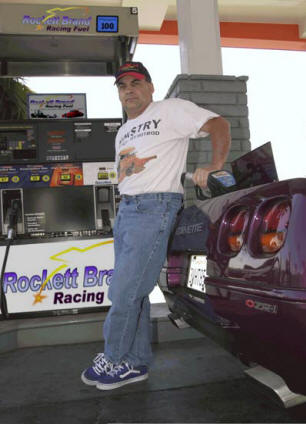
You're leaning against your Corvette, holding the gas nozzle lever open, watching the counters flash. Sound familiar? Beyond reading the price and the octane on the pump, ever wonder about what goes into your Vette's tank? If you have; read on. We're going to cover some high-profile, gasoline issues of interest to Corvette enthusiasts.
Gasoline is a mix of volatile, flammable, liquid hydrocarbons. "Volatile" means it readily evaporates. "Flammable" means its vapor is combustible. "Hydrocarbons" are compounds of hydrogen and carbon. When hydrocarbons are burned in an engine, expanding gases apply force to its pistons and that's what makes your car go.
Many hydrocarbons are in crude oil. To extract the specific hydrocarbons that make gasoline, "crude" is processed or "refined" by one or a combination of: "distillation", "cracking," or "polymerization". The first boils crude in a vacuum to separate it into various factions, of which gasoline is one. The other two chemically modify hydrocarbons to give them desired properties.
Research for this article led The Idaho Corvette Page to Tim Wusz, an engineer at Rockett Brand Racing Fuel. Wusz has worked for Rockett and its predecessors, 76 Performance Products Division of Conoco/Phillips, Tosco Corporation, Unocal, and Union Oil Company since 1965, spending much of that time developing racing gasolines. Wusz is a former drag racer, a long-time musclecar nut and a former Corvette ZR-1 owner.
The Basics of Blending
"A ‘barrel' of crude oil," Tim told us, "is 42 gallons and about 50% ends up as gasoline. After refining, we're left with gasoline ‘components' or ‘blend stocks,' segregated in tanks connected to a ‘blend header' containing computer-controlled valves which meter flow from each tank. Gasoline is mixed in this blend header then subjected to quality control such as ‘on-line' octane testing and sampling for chemical analysis.
"During blending, we select various hydrocarbons, depending what we want from the gasoline. For example, with gas for street applications, warm-up is critical. If the engine hesitates or dies during warm-up, exhaust emissions and customer satisfaction are impacted. For racing applications, we're more concerned with octane quality and resistance to vapor lock."
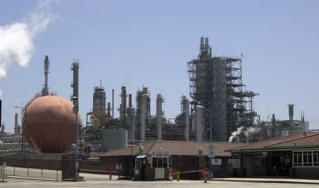
A typical oil refinery, south of Los Angeles, in Wilmington, California. This facility is a major source of gasoline for southern California. The tall tubular structures are distillation and cracking towers.
Image: author.
To burn in an engine's cylinders, gasoline must vaporize. "Volatility" describes gasoline's tendency to vaporize. Pump gas is blended for slightly more volatility and better warm-up. Gasoline blends are changed seasonally to give consistent drivability. In cold weather, volatility is increased and in warm weather, it's reduced. Racing gas typically has less volatility to resist vapor lock.
You might think Corvettes stored during winter shouldn't have full tanks because of vapor-lock problems when using "winter" gas the following summer. Tim Wusz told us that with '74 and earlier Corvettes lacking rubber bladders in their fuel tanks, moisture in an empty tank is a bigger problem than vapor-lock and he recommends storage with a full tank. Once spring arrives, it won't take long to dilute the winter gas with summer gas.
We asked Tim about "shelf life." "Gasoline is designed for cradle-to-grave of about six weeks. In normal use, it is seldom stored for longer than that, however, it has enough stability so storage for a year is not a problem."
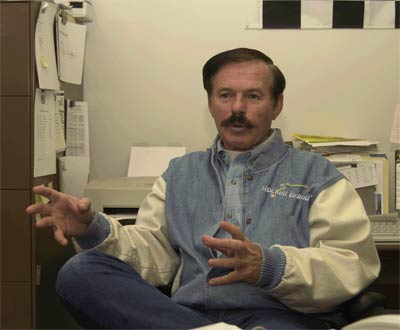
Engineer, Tim Wusz, at work in the Rockett Brand's gasoline quality lab. Most racing gasolines get additional quality control verification steps over what's done at a refinery. In the case of Rockett, these steps are performed by Wusz at the Rockett's facility in Yorba Linda, California.
Image: author.
You'd think the challenge in blending gasolines would be quality control but, according to Tim Wusz, "The biggest problem is meeting government requirements for volatility, octane, oxygen content, distillation curve and other things. I don't know if any one requirement is more difficult but the combination makes the blending engineer's job challenging.
"California has its own requirements and is the only state that does. The rest of the country comes under slightly less restrictive, Federal requirements. At one time, we felt handicapped by California's requirements, but now, gasoline for California is better performance-wise than gas sold in any other part of the country.
"This benefit carries to unleaded racing gasolines sold for street use, too. Rockett Brand 100 is refined to California specifications and is capable of slightly better performance than if it was refined to Federal specifications."
Additives, other than gasoline components, are blended in for special purposes. Typical additives are: anti-oxidants and metal deactivators (both inhibit gum formation and improve stability), deposit modifiers (reduce deposits, spark-plug fouling and pre-ignition), surfactants (prevent icing, improve vaporization, inhibit deposits and reduce certain emissions), freezing point depressants, corrosion inhibitors and dyes (for safety or regulatory purposes). Additives are used in very small amounts, usually 50-100 pounds per thousand barrels of gasoline.
Oxygenates in RFG
A major difference between many pump gases and most racing gas are oxygen-bearing chemical compounds, or oxygenates. "Two oxygenates are used." Tim Wusz told us, "One is MTBE–Methyl Tertiary-Butyl Ether–and the other is ethanol. MTBE is an ether compound and ethanol is an alcohol. Both were originally blended into gasoline to increase octane but later found to reduce exhaust emissions. Both have oxygen in their molecules and reduce emissions by enabling more efficient combustion."
The Clean Air Act of 1990 mandated oxygenated gasoline and its newer, more complex sibling, reformulated gasoline (RFG), in parts of the country with air quality problems. The intent was hydrocarbon and carbon monoxide emissions reductions beyond those possible by '80s emissions controls alone. Widespread distribution of gas oxygenated with MTBE began in the early-90s but, in the late-‘90s, after MTBE's classification as a "possible human carcinogen" and being documented as a ground water pollutant, public opinion built to eliminate it.
By the mid-'90s, improvements in combustion chamber design, emissions control hardware and engine controls software accomplished significant HC and CO reduction, in spite of RFG. With the amount of pre-mid-90s vehicles on the road decreasing, RFGs are becoming a solution looking for a problem. That and political pressure has, in most states, made MTBE a piece of history. California outlawed it on Jan. 1, 2004. A dozen other states have also outlawed it since then and the rest of the state will follow in 2005.
Enviromentalists never give up, so ethanol has become the new mainstream oxygenate and it's here to stay. California requires at least 5.8% ethanol in pump gas. Other states may differ but, generally, ethanol content varies from 6-to-8 percent and goes as high as 10%. While cars built in the last 5-7 years don't require oxygenates to achieve low emissions, ignorance or disbelief of that by environmental activists along with resistance to ethanol's elimination by its producers and that it's the oxygenate-of-choice for RFG in areas where MTBE has been be banned make its presence in gasoline inevitible and permanent.
A downside of RFG can be overly-lean air-fuel ratio when burned in 1970s Corvettes with stock carburetors having lean calibration to reduce emissions. Performance and drivability may be compromised by existing calibration combined with additional leaning due to RFG. The solution is to slightly richen the calibration. Engines built before the late-'60s often ran slightly rich and have little problem using oxygenated fuels.
Two additional caveats apply to ethanol RFG in some older vehicles. It may release scale from the walls of old fuel tanks. The solution is either frequent replacement of fuel filters while the scale is going through the system or a new tank. Ethanol is incompatible with some types of fuel hose. If hoses date to before 1985, replace existing hose with modern products, all of which are compatible with RFG.
What's Up with Octane
In the combustion chamber, after the spark plug lights the air-fuel charge, a "flame front" burns away from the plug. This burning needs to be controlled if the engine is going to perform well and last a long time.
"Detonation" is rapid, uncontrolled combustion. It occurs after ignition, when the unburned charge ahead of the expanding flame front is compressed to the point of auto-ignition. If a significant amount of unburned charge auto-ignites, detonation will be audible and will generate intense pressure waves which cause the chamber walls to vibrate. You hear that as a knocking or pinging sound. This pressure builds quickly, before the piston reaches top dead center. When downward force builds before the piston changes direction, stress on it and other parts is significant as is the performance loss. Detonation also sends combustion temperatures soaring. The stress and temperature make even moderate detonation problems capable of damaging the engine in your Corvette.
"Octane" or "antiknock rating" is a measure of a gasoline's resistance to detonation. Two ratings are common: "research octane number" (RON) and "motor octane number" (MON). Tests for both use a single-cylinder engine having a variable compression ratio. The engine is run on a gasoline to be rated and the compression ratio is varied to obtain a standard knock intensity measured by an electronic knockmeter. The octane of the sample is determined by comparing its knock tendency with that of reference fuels having known octane numbers.
The MON test, because of faster engine speed, higher mixture temperature and variable spark timing, better simulates conditions in an automotive engine and is, Tim Wusz told us, "... more relevant to the enthusiast trying to understand gasoline. In a real world engine, MON is necessary at wide-open throttle. It is an important number for high-performance engines since they spend a high percentage of their lives running at high speed under high-load."
The Federal Government requires octane of gas sold for road use be rated by an average of RON and MON ("R+M/2") and that number must be on a yellow sticker applied to the gas pump. In many places, regular unleaded is 87-octane, mid-grade is 89 and premium varies from 91 to 93 octane. In high-altitude areas, you'll find lower octane gas. "Pressure and temperature in the combustion chamber are less at altitude." Wusz stated. "Engines needs less octane so Government allows lower octane fuel in counties having a large majority of their territory above 4000 feet."
Will high-altitude gasoline damage an engine requiring a higher octane? Not if you stay in the high country or, if you drop below 4000 feet, you don't run the engine hard until the high altitude gas is used or diluted with "sea level" gas.
Do refiners save money selling lower octane fuel in mountain areas? Nope. They loose any savings in transportation costs. Most refineries are near coastal areas so most gasoline is transported to interior states. The farther it's moved, the more expensive it becomes.
So...how much octane do you need?
Only enough to keep your Corvette's engine out of detonation. More than that offers no performance advantage. How do you determine an engine's detonation threshold? By testing and the first test instrument is your ear. If you hear detonation at wide-open throttle, you have a problem. If there's no engine-related trouble (ie: too much spark advance, lean mixture, etc.) causing the detonation, then you need more octane.
Plug reading can also identify a detonation problem. If you see tiny flecks of aluminum on the plugs, that's evidence of detonation. Severe detonation may melt electrodes and/or crack the center insulators.
All 1982 or later Corvettes, have feedback control of spark advance and will be equipped with a knock sensor (KS). If the KS "hears" detonation, the engine computer's software retards the spark enough to stop the detonation. The '82 or later cars offer access to the computer's serial data stream for diagnostic purposes. You can use a "scan tester" (either software-based, such as "Diacom", or a dedicated piece of hardware, such as the Vetronix TECH 1A, TECH 2 or Mastertech) to view the KS signal and/or the spark retard value. If you can read either of those on a road test and you see detonation with the tester and know there's no engine-related trouble causing it; then you need higher octane gas.
Get the Lead Out.
The octane and valve-seat-durability enhancing qualities of alkyl-lead compounds (chiefly tetraethyl lead, aka: "TEL" or just "lead") were discovered in 1922 by General Motors. By the late-'20s, "leaded" gas became available and, by the early '50s, TEL was in virtually all gas sold in the U.S. By the late-'60s, "super premiums" averaged 3.5-grams TEL per gallon and were around 100 RON. While TEL was a cheap way to improve engine performance and durability, it is toxic, both unburned and in lead-oxide-particulate form in exhaust gases.
In the late 1960s, concerned with environmental effects of TEL, the Federal Government legislated its phase-out. Gasoline retailers had to make unleaded gas available by July, 1974. Following that, stepped limits on alkyl-lead ("low-leads" of the '70s and '80s) were enacted starting with 1.7 grams per gallon in 1975 and dropping to 0.1 g/gal. in 1986. To meet emissions regulations for model year 1975 (MY75) some manufacturers added exhaust system catalytic reactors to their vehicles and GM did that with Corvette. By MY80, all light duty vehicles had them. Also known as, "catalytic converters", "catalysts" or just "cats", these reactors convert pollutants to non-polluting substances. This ability is destroyed by alkyl-lead so any catalyst-equipped vehicle had to use unleaded gas. As a result, leaded gas use peaked in 1977, then declined significantly. In December, 1995, use of gasoline with more than 0.05-gram alkyl-lead per gallon (in a practical sense, all leaded gas) by any on-highway vehicle built after MY75 was outlawed.
Lead's phase-out forced octane reductions. While it didn't cause detonation in new Corvette engines, because, starting in MY71, GM had already lowered compression ratios as a technical answer to government's restriction of oxides of nitrogen (NOx) emissions; it did cause detonation in '50's and '60's high compression engines. The phase-out, also, eliminated alkyl-lead's valve seat protection, forcing an industry-wide, cylinder head manufacturing process revision: the addition of induction-hardened seats to the cast iron heads common back then. Aluminum heads have no problem because they use hard, steel valve seat "inserts."
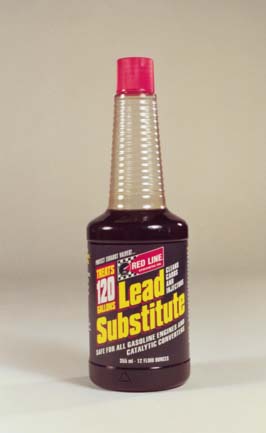
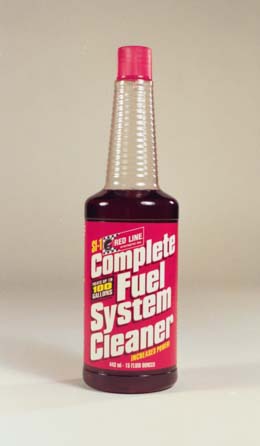
Red Line's Lead Substitute is the ideal solution for engines that don't need octane any higher than that of pump gas but do need the valve seat protection once available with leaded fuel. Red Line's other gasoline-related product, Complete Fuel System Cleaner, is a solvent-based fuel injector and fuel system cleaner that is one of the most effective products of that type on the market.
Images: Red Line Oil.
By the mid-'80s, car companies learned to better control emissions and refiners developed higher octane unleaded, so compression ratios began to climb, again. These modern unleadeds are blended with aromatic hydrocarbons, which raised their antiknock rating. To a lesser extent, the addition of oxygenates also increased octane.
If an engine using unleaded gas has heads lacking induction-hardened seats or hard seat inserts, "valve seat recession" may occur. Metallic oxides resulting from lead's combustion leave a protective coating on valves and seats. Without that coating, when valve temperatures are high, during severe duty or extended operation with lean mixture, microwelding transfers softer seat metal to the valve face causing the seat to recede into the head. Wear debris cause additional damage to valve stems and guides. Exhaust valve rotators, used in some engines, accelerate valve seat recession. The end result is poor valve sealing and eventual cylinder head repair or replacement.
Heads lacking hard seats on Corvette engines burning unleaded will have durability better than urban legend leads many to believe. If you've got old heads on a show car or weekend cruiser that sees low annual mileage and rare high-rpm/high-load use; problems from valve seat recession are unlikely. If the car sees high annual mileage or you drive it hard on a regular basis, then you need to either: retrofit hard seats to your heads, install later heads with hard seats or add something to gasoline to inhibit valve seat recession.
There are pour-in additives that address this problem. The Idaho Corvette Page has test data showing Red Line Synthetic Oil Corporation's "Lead Substitute" is an outstanding solution to valve seat recession. Lead Substitute uses a sodium-based chemistry which forms sodium oxides upon combustion offering protection similar to that of TEL. Red Line Lead Substitute comes in 12-oz. bottles, is mixed 1-oz. per 10 gallons of fuel and should be used in every tank of gas for best protection.
Octane boosters–do they work?
While a few canned, liquid, "octane boosters" can raise octane, their practical benefits are often overstated. Common claims by these products' manufacturers are: they increase octane by so many "points." These "points" are seldom quantified, but the implication some manufacturers hope consumers will make is: one point equals one octane number. Sometimes these "points" are tenths of an octane number, ten times less than what some consumers may believe.
Manufacturers may not admit the tests supporting their performance claims were done with 87 octane gas. Most boosters, if effective at all, work better with regular gas than with the higher octane, premium unleaded to which most people will add them.
The Idaho Corvette Page interviewed Jim Bell, who runs Kenne-Bell Performance Products, a manufacturer of aftermarket supercharger kits. In developing blower kits and supporting the customers who buy them, Kenne-Bell has tested many octane boosters. "Don't waste your time with boosters that use alcohol because they don't do anything," Bell told us. "The ones that say they have lead in them, don't work, either, because the amount of lead is so small. The only boosters we've found to be worthwhile are those that use MMT and one we recommend is the NOS brand."
MMT stands for–try this tongue twister: methylcyclopentadienyl manganese tricarbonyl. Once viewed as a possible replacement for TEL, while not as potent, it still increases octane and, in large quantities, can eliminate valve seat recession. While it's used in Canada, MMT is ignored by refiners in the U.S. in favor of other antidetonants, mainly because it's illegal in areas where RFG is required and a few refiners feel its long-term use might compromise engine life. MMT is shunned by car companies due to durability concerns about components in on-board diagnostic and emissions control systems and questioned by the EPA as a possible health hazard. Nevertheless, in 1995, MMT was allowed on the U.S. market with some restrictions after its manufacturer won a Federal court case against the EPA. At this writing almost no U.S. refiners add MMT to gasoline, but it is the key ingredient in a few canned octane boosters.
The Idaho Corvette Page acquired octane booster test data from an independent research laboratory. The first test was straight 92-octane unleaded gas from a Chevron station in southern California. It tested at 96.3 RON and 88.3 MON for an R+M/2 rating of 92.3, 0.3-oct. higher than the rating on the pump. To a second sample of Chevron 92 from the same station, the lab added "104 Octane Boost". The octane of the gasoline modified with this booster was unchanged. The lab tested a third sample of Chevron 92 and NOS brand "Street Formula", a MMT octane booster, mixed 1:170 (12-oz. bottle in 16 gal. of gas). The results were: 96.8 RON, 88.4 MON and 92.6 R+M/2, a measurable change but, clearly, as the MON went up only 0.1-oct, not a practical improvement. NOS' most potent booster, "Racing Formula", another MMT-based product, in Chevron 92, tested at 98.5 RON, 90.4 MON and 94.5 R+M/2, a credible but modest improvement.
Before we get farther into testing, we should advise the reader that some of the research for this article was done in 2001, just before a change in premium unleaded fuel in the western United States from 92-octane to 91-octane. Some of the testing done for this article was with 92-octane fuel, however, some additional testing and price research was done, later, with 91-octane fuel. We apologize for the confusion but, unfortunately, we had no control over it.
That NOS octane booster lab-tested reasonably well intrigued us enough to give it a practical test. We picked a 1995 ZR1. In hot weather, the ZR1's LT5 engine, when run on premium unleaded pump gas, will detonate under high load and, thus, will have spark retard as a result of knock sensing by the engine computer. We demonstrated this by running the car on a Super Flow SF-840 "Auto-Dyn, dual-mode chassis dynamometer at Westech Performance Group in Mira Loma, California while monitoring the engine controls data with a Vetronix Mastertech scan tester. The engine intake air temperature (IAT) was 108 degrees F. Between peak torque and peak power, the Mastertech showed 5-8 degrees spark retard on each of several dyno tests.
The car had 15 gallons of Chevron, premium unleaded in it when we added one bottle of NOS "Racing Formula", drove it 5 miles to mix the booster thoroughly then put the car back on the Auto-Dyn. This time, in spite of the IAT climbing to 115°F, the Mastertech showed a maximum of two degrees retard and, on three of six passes, it read no spark retard at all. Run #5 was the best with power at the rear wheels up almost nine horsepower because the gasoline's octane was, now, just high enough to tolerate full spark advance.
Clearly, boosters with enough MMT to be effective are good for occasional, limited increases in octane. Applications might be: 1) a stock, pre-'71 Corvette having a compression ratio between 9.5:1 and 11:1, 2) a late-model C4 or C5 modified with a low-boost, streetable supercharger kit or a "mild" nitrous oxide injection system or, 3) a late-model car, such as our ZR1, that experiences loss of performance on hot days when its engine controls retard timing due to detonation.
If you want to make pump gas into "racing gas" for engines with 11:1 or more compression, high-boost superchargers, big doses of nitrous or any engine run on a race track at sustained high-speed/high-load; forget it. No canned octane booster in any quantity will fail to stop detonation under those conditions.
If you "read" spark plugs to tune your engine, the redish-brown MMT residue makes useful readings impossible. Levels of MMT octane boosters just moderately beyond the recommendations of booster manufacturers will foul spark plugs, damage oxygen sensors (O2S) and plug catylitic converters. High percentages of MMT contaminates engine oil and leaves hard metallic deposits in the combustion chambers, piston tops and upper end of the cylinder walls such that engine wear is greatly accelerated. Do not use them in concentrations higher than suggested by their manufacturers.
NOS Racing Formula should be mixed one bottle to about 16 gallons of gas. Lab testing and our dyno test showed this product to be a useful octane booster but, in most cases, not as economically attractive as mixes of racing gas and pump gas. Image: author.
That some automotive manufacturers believe MMT causes problems with the second generation on-board diagnostics (OBD 2) on '96 or vehicles has us concerned about long-term use of MMT boosters in OBD2 engines. We would not use a MMT octane booster in a Corvette with OBD2. In fact, we're not even comfortable with long-term, regular use in any engine with 02Ses and cats, OBD2 or otherwise.
While some of them have a short-term practical benefit, the economics of octane boosters aren't much better than mixes of pump and racing gas. Factor in the durability issue and they might not be as good a value. We priced NOS Racing Formula on the Internet and at retail vendors. It averaged $12.99 per bottle. At time this article was posted on the Internet, 91-oct. was going for $2.59.9@gal. at local gas stations and we purchased "Rockett Brand 100" unleaded (106 RON, 96 MON, 100 R+M/2) for $4.75@gal. Sixteen gallons of 91 boosted to 94.5-oct. with a bottle of NOS ran $54.57. Sixteen gallons of 94.6 octane gas mixed 3:2, from 91 and Rockett 100 unleaded cost $55.35, seventy-eight cents more. Considering the two mixes differ in price by a little over 1%, the engine and emissions controls component damage you risk with MMT boosters seems to point at racing gasoline rather than octane booster as the sensible way to raise the octane of pump gas.
How 'bout AvGas?
The only aviation gasoline of interest to Corvette enthusiasts is "low-lead 100" (AvGas LL100). Because of its antiknock rating and low price compared to leaded racing gasolines, AvGas might seem a good choice for a moderate octane boost, but closer study raises some doubt.
Because of its lead content, AvGas must not be used by engines fitted with modern emissions controls. It renders catalysts useless in short order and will eventually plug them. AvGas quickly damages most oxygen sensors, too.
The sale and use of aviation gasoline is heavily-regulated. Most aircraft fuel dealers refuse to put AvGas into anything other than an aircraft fuel tank. There is a legal gray area that has some vendors willing to dispense AvGas into approved containers if they believe the end use of that AvGas is fueling an aircraft engine. This loop-hole is how some people obtain AvGas for automotive use.
Aviation gas is formulated for large-bore, long-stroke, low rpm engines which run at high altitude. While AvGas' higher octane is useful, smaller-bore, shorter-stroke, high-rpm, non-cat, Corvette engines requiring 92-98-oct. will perform better on racing gasoline. AvGas has lower volatility so, used in proportions higher than about 40%, part-throttle drivability and cold starts may be compromised. AvGas has a lower specific gravity so it will require a change in air-fuel ratio calibration for the engine to perform at its best. LL100 is blended with a high percentage of aromatics. That reduces throttle response–not really an issue with an aircraft engine but certainly an issue in a high-performance automotive engine.
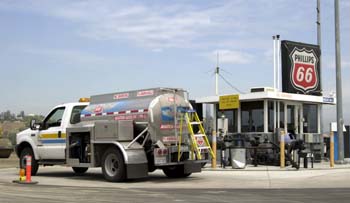
Most small airports that cater to general aviation will sell AvGas through fueling facilities such as this. If you decide to accept the compromises of aviation gasoline, make sure what you buy is "100" or "100LL". Do not use "Jet A". That's jet fuel, a form of kerosene, and burning it in an automotive engine will cause serious damage.
Image: author.
The "Aviation" antiknock rating system is different than the MON rating. 100-oct. on the aviation scale, equals 98.8 MON. The biggest limitation of LL100, when used in very high-compression or high-boost, race track applications requiring leaded gas is octane. "For those applications, AvGas," Tim Wusz told us, "is short on octane compared to most (leaded) racing gasolines. Many racing engines have more spark advance at low rpm and/or during lean, part-throttle operation than AvGas and even some (unleaded) racing gasolines can handle. The result is detonation."
Bottom line: AvGas is ok in off-road situations were a leaded fuel of no more than 98 octane required, ultimate performance is not important and you can accept possible drivability quirks.
Blend Your Own Race Gas? Not.
If you're a regular reader of the VetteNet mail list or visitor to the techie boards on the Corvette Action Center, you've heard of other do-it-yourself additives said to improve gasoline. Unfortunately, a lot of that is urban legend. The executive summary of "DIY race gas" is: mixing it can be dangerous. You sometimes loose performance. You don't save money.
Some of these DIY additives are: aniline, benzene, toluene, xylene and propylene oxide. Forget the first two. Both are highly toxic. Aniline is absorbed through the skin and impairs your blood's ability to carry oxygen. Handle aniline improperly and you die. Benzene is a carcinogen, so you'll die after improperly handling it, too–it'll just take longer. Their toxicity and that they are used in making drugs has aniline and benzene Federally-regulated and not available to the public.
The aromatic hydrocarbons ("aromatics"), toluene and xylene are octane improvers. Significant amounts of toluene and lesser amounts of xylene are already in pump and racing gasolines. Both are available from automotive paint suppliers. Both are mildly toxic. Work with them wearing chemical-resistant gloves and in a ventilated area. If there's any question about ventilation, wear a respirator.
The aromatic hydrocarbons ("aromatics"), toluene and xylene are octane improvers. Significant amounts of toluene and lesser amounts of xylene are already in pump and racing gasolines. Both are available from automotive paint suppliers. Both are mildly toxic. Work with them wearing chemical-resistant gloves and in a ventilated area. If there's any question about ventilation, wear a respirator.
In California, law restricts aromatics to 35% of a gasoline blend. Elsewhere it may be as much as 40%. The effect additional toluene or xylene has on pump gas is unpredictable for two reasons: 1) the octane boosting ability of both is less effective on premium pump gases than on regular grade gas because of the aromatics premium gases already contain, 2) toluene and xylene have high octane ratings alone but may have lower octane when blended with other gasoline components and must be carefully tested when mixed with other gasoline components.
Toluene and xylene have specific gravities higher than pump gas so the more of them you add, the leaner you need to calibrate the engine's air/fuel ratio. Once you calibrate for toluene- or xylene-spiked, DIY racing gas; don't go back to running conventional gasoline until you recalibrate to a richer mixture or you'll be burning pistons.
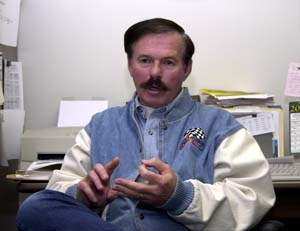
"Adding more toluene," Tim Wusz told us, "will increase the octane numbers of the gasoline, but when you get above 45 or 50%, throttle response is poor and the flame speed is reduced to where increasing amounts of fuel are still burning as combustion gases are forced out the exhaust valve. Once that happens, power is lost, not gained."
Image: author.
Both have less volatility, so engines burning gasolines laced with high concentrations of them can be more difficult to start when cold.
In addition to handling, mixing, calibration, drivability and performance problems associated with DIY race gas, it has a lousy business model, too. A late-model Corvette with a medium-boost, aftermarket supercharger kit at the drag races on a warm day might need 97.2-oct. to keep the engine out of detonation. Toluene, used as a blending component, is 103.5-oct. To make 10-gal. of 97.2-oct., DIY race gas (1:1, 91-oct. unleaded and toluene) costs $42.80. Do it with 91 and 100 unleaded gasolines, you mix 3:7 for $32.05. Because a 1:1 mix of toluene and pump gas costs you performance and throttle response due to slow burn speed; not only is DIY race gas a lot more expensive, but it won't perform as well, either.
The economics of xylene are worse than toluene. Xylene from industrial sources is "mixed-isomer" and has less octane boosting ability than toluene and a higher unit cost. The higher octane, single isomer varieties of xylene, typically obtained through science and laboratory supply businesses, are obscenely expensive, upwards of $100 per gallon.
Misunderstanding surrounds propylene oxide. Common uses for it are pesticide and fumigant. While the EPA lists it only as a "probable carcinogen," ingesting propylene oxide will at least make you sick and can cause coma or death. Use care when handling it. Some racers are under the impression "P.O." is an octane booster, but it is not. It is an oxygenate that works like nitrous oxide but not as well. "It will improve performance," Wusz stated, "but the mixture must be richer to take advantage of that. PO is more effective than MTBE but less effective than nitrous. The downsides of PO are: 1) it attacks plastic and rubber parts in fuel systems and 2) its low, 95 deg. F boiling point gives it a tendency to easily escape from a blend leaving the DIY race gas blender with a gasoline which he thought contained a certain amount of PO, but in reality, may have retained far less of it. This makes tuning exceedingly difficult."
Bottom line: brewing your own race gas a foolish move for a lot of reasons. You're better off buying it ready-made.
Racing Gas
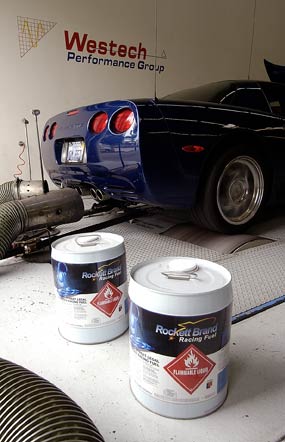
Our dyno test showed the best gasoline choice for a computer-controlled car that sees a little detonation on hot days is a mix of racing gasoline and pump gasoline.
Image: author.
Many think racing gasoline is just for racing but, in recent years, the term has also come to mean high-octane, unleaded used by street cars. The obvious reason to use race gas is higher antiknock rating, but just as important is: it's an optimum, balanced blend of hydrocarbons and additives intended to produce the highest possible performance from a high rpm, automotive engine. It's better than pump gases fortified with octane boosters, better than AvGas, better than pump gases spiked with store-bought aromatics and the only alternative if you want your engine to perform best. There are 10 vendors of racing gas in the United States. Most sell through distributors, however, in a few urban areas, some refiners sell racing unleaded at retail service stations.
"Entry-level" racing gasolines are usually unleadeds of about 100-oct., R+M/2. Eight of the 10 companies sell it. Octane ratings vary from 93 to 99 MON, a significant gain over the approximately 88 MON of the best pump gas. Racing unleaded is the perfect choice if the engine in your Corvette needs a moderate octane boost. It is good for engines with superchargers of moderate boost, modest nitrous oxide injection systems or any modifications that increase cylinder pressure somewhat over stock levels.
We asked Tim Wusz about Rockett Brand 100 and he said, "This product has been used in endurance (sports car) racing in four-inch bore engines with 14:1 compression ratios and aluminum heads. With cast iron heads, compression ratio should be limited to 12:1. It can be used in current performance street cars. Historic muscle cars can also benefit from this product which easily services the 11:1 compression ratios of many engines from that era."
When late-model Corvette is run hard on hot days, as shown in our tests on the SuperFlow Auto-Dyn with the ZR-1 and later with a Z06, engine computers will often enable spark retard. This is because the car's engine controls are calibrated for aggressive spark advance to get best performance in cool weather, then "save" the engine with spark retard when mild detonation is sensed during high-load/hot-weather operation. Because of the retard, their performance is reduced slightly and coolant temperature is slightly higher.
On cool days there's no problem, but in warm weather, the engine will get a little detonation, the knock sensing will retard spark and performance will drop slightly. A small amount of unleaded race gas mixed with premium pump gas (start at 1:5, then work up) is the best way to eliminate this problem, short of engine modifications, changes in calibration or moving to a cooler area.
Does this work in practice? At our shop, we drained our test Z06's fuel tanks, added 10 gallons of Rockett Brand 100 then drove 50 miles to a session on the Auto-Dyn at Westech. The IAT was 106°F and the dyno read 9.5hp more than the first test on straight unleaded premium. After lunch, we "thinned" the remaining Rockett 100 down to 94.6-oct. by mixing it 2:3 with Chevron 91-oct. unleaded and ran again. The IAT was now 109 and the power was up 7.5hp over straight pump gas. In all runs of this second round of tests, our Vetronix Mastertech showed no detonation. Clearly, in hot weather, unleaded racing gas works well as a detonation fighter.
Some think unleaded race gas is prohibitively expensive but, for a given octane, compared to pump gas spiked with pour-in additives; its economics are usually more favorable. Don't think you have to use racing unleaded at full strength, either. If your engine only needs 94.0 octane, mix it 1:2 with 91-oct. pump gas. It's relatively easy to "math out" the proportions of the mix you want and some race gasoline suppliers have mixing charts, such as the ones from Rockett Brand Racing Fuel reproduced here, to make the process easier.
While it is true that your engine only needs as much octane as is necessary to keep it out of detonation, there are cases were a particular engine will run better on a high-percentage mix or straight 100 unleaded in spite of not needing additional octane. There's no set rule on this and we suggest, once you've determined the ideal mix of pump gas and 100 unleaded to keep you out of detonation that you, also, run a test of straight 100 unleaded. In some cases the different components in the 100 unleaded and its slightly faster burn speed will improve performance even more.
A few of these unleadeds–Rockett Brand 100, for example–are street-legal in all 50 states. Another attractive feature of some, like the Rockett Brand 100 sold at Rebel stations in southern Nevada and at Gas City stations in the Chicago area, is the convenience of buying high-octane, street-legal gas at a service station–no searching for distributors, no hauling cans around and no storing gas in your garage. Just drive up to to the island, stick the nozzle in the tank and pump your Corvette full of 100-oct. unleaded race gas.
The bread-and-butter of the racing gasoline business is leaded fuel. It is the best choice for racing engines requiring more than 100 octane. All vendors marketing leaded race gas have several grades available.
Some racing gasoline vendors make available charts like this to assist users in mixing unleaded racing gas with premium unleaded pump gas. Rockett Brand Racing Fuel has charts for 91-, 92- and 93-oct., too.
DOWNLOAD CHARTS - PDF Format
Blend Chart 90
Blend Chart 94
Graphic: Rockett Brand Racing Fuel.
DOWNLOAD CHARTS - PDF Format
Blend Chart 90
Blend Chart 94
Graphic: Rockett Brand Racing Fuel.
"We have four leaded race fuels:" Tim Wusz continued, "The first three are Rockett Brand 111, 114 and 118.
"111 is our highest volume racing gas. For 53-years, it was the official gasoline for NEXTEL Cup Racing and all other NASCAR series. It's used by lots of ‘Saturday night' racers in all types of competition using all varieties of engines.
"114 is more for bigger engines. Drag racers with big motors in SuperComp and SuperGas like it. It's good because large engines often need more octane. It's for medium supercharged applications, too.
"118 was originally developed for ProStock and worked well until so-called ‘fast-burn' gasolines came along. The 118 is ideal for high-boost, supercharged applications. It's also good in engines running a lot of nitrous oxide. The 118 has a little faster burn characteristic than the 114, but not as fast as our fast-burn gas.
"We have another fuel, ProStock+, that's really better than the 118 for performance in certain applications but, because of different burn characteristics, it's around 114 octane. It's a very fast-burning gas for use in very high-rpm, normally-aspirated engines. It was developed for NHRA ProStock. Because of their high rpms, they need the faster burn speed, otherwise you open the exhaust valve and loose a lot of unburned hydrocarbons. If you increase the gasoline's burn speed, you use that stuff, rather than flushing it out the exhaust, and the engine makes more power."
Most of the other vendors have between 3 and 5 grades of leaded race gas and one company, VP Racing Fuels, has a mind-boggling, 14 different grades. If you are having difficulty making a decision about racing gasoline, contact the suppliers of these products for detailed information and recommendations.
The Future
The United States EPA announced in late 2000 it intends to discourage off-highway use of leaded gas. EPA is putting pressure on the general aviation community to accept unleaded AvGas and it also wants motorsports sanctioning bodies, particularly NASCAR, to adopt unleaded gasoline. You can bet, if NASCAR goes unleaded, other sanctioning organizations will follow. We asked Tim Wusz what plans racing gasoline vendors have if NASCAR goes to unleaded fuel.
"We did test work over five years ago with unleaded gasoline in Busch Grand National cars without any significant adverse effects. For current, 12:1 compression ratio engines required in NASCAR NEXTEL Cup, Busch and Truck Series, our hundred octane unleaded is adequate, but we have to convince the racers and, to do that, we need the support of the sanctioning bodies. A few years ago when compression ratios were 14:1, we tested unleaded in a Winston Cup engine that had pressure transducers in all eight cylinders. We found the 100-oct. unleaded ran with no detonation. (Ed note: this test was under wide-open throttle conditions and included no part-throttle, lean mixture operation typical of running in caution periods or of engines not calibrated properly for part-throttle operation) This engine was optimized with 34-degrees spark advance. Then, we started bumping the timing up. We got up to 42-degrees before there was any indication of detonation. Normally, two degrees is an octane number so we had a cushion of about four octane numbers."

"At Rockett, we have the technology to make a 105-octane unleaded but right now, the demand for it just isn't there." Tim Wusz commented.
Image: author
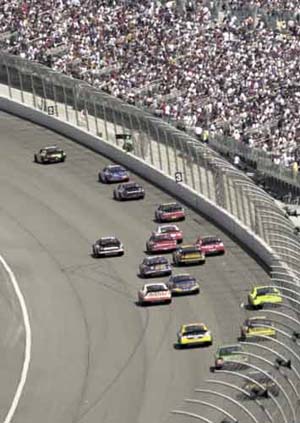
If there is a conversion of motorsports to unleaded gas, perhaps the first place we'll see it is in NASCAR Winston Cup racing. The huge appeal of NASCAR would be a major factor in marketing the switch to unleaded gasolines to motorsports, however, at this point in time (late-2004) it doesn't look like a switch will happen anytime soon.
Image: author
In NASCAR and other forms of racing that put similar demands on gasolines, the change to unleaded may be more of a cultural challenge, however, unleaded gas might be a significant technical problem in other parts of the sport. It would be a tough sell in some categories of drag racing, as well as a few other motorsports that use gasoline engines with very high compression ratios, high levels of supercharger boost, big shots of nitrous, large combustion chambers or any combination of these.
"The Clean Air Act has always exempted motorsports from a mandated conversion to unleaded," Wusz continued, "so all the EPA and other governmental entities can do is discourage the use of leaded gasolines and request a change to unleaded." He went on to say that the November 1999 election of President George W. Bush changed the landscape as far as the EPA's interest in seeing a conversion to unleaded racing gasolines was concerned with the threat being greatly reduced.
At this writing (early December, 2004), with Bush going back to the White House for another four years, motorsports seems pretty safe from new pressure to go unleaded, however, if in '09, after the next presidential election, the winds of change start blowing again; Rockett Brand Racing Fuel and other providers of racing gasolines will be ready with an unleaded products suitable for NASCAR and many other types of competition.
Sources:
Rockett Brand Racing Fuels 22349 La Palma Av. #104
Yorba Linda CA 92887
800-345-0076
info@rockettbrand.com
Red Line Synthetic Oil Corporation
6100 Egret Court
Benicia CA 94510
800 624 7958
www.redlineoil.com
6100 Egret Court
Benicia CA 94510
800 624 7958
www.redlineoil.com
Vetronix Corporation
2030 Alameda Padre Serra
Santa Barbara, California 93103-1716
www.vetronix.com
2030 Alameda Padre Serra
Santa Barbara, California 93103-1716
www.vetronix.com
Westech Performance Group
Unit C,
11098 Venture Av. Mira Loma CA 91752
909-685-4767
www.westechperformance.com
Unit C,
11098 Venture Av. Mira Loma CA 91752
909-685-4767
www.westechperformance.com
VP Racing Fuels, Inc.
Box 47878
San Antonio TX 78265
210 635 7744
www.vpracingfuels.com
Box 47878
San Antonio TX 78265
210 635 7744
www.vpracingfuels.com
Ches Koblents
July 7, 2018
July 7, 2018